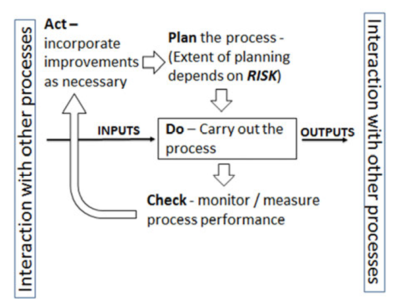Deming wheel: Difference between revisions
(The LinkTitles extension automatically added links to existing pages (<a target="_blank" rel="noreferrer noopener" class="external free" href="https://github.com/bovender/LinkTitles">https://github.com/bovender/LinkTitles</a>).) |
(The LinkTitles extension automatically added links to existing pages (<a target="_blank" rel="noreferrer noopener" class="external free" href="https://github.com/bovender/LinkTitles">https://github.com/bovender/LinkTitles</a>).) |
||
| Line 57: | Line 57: | ||
PDCA cycle was popularized as a tool of [[Total Quality Management]]. It was also included into [[process approach]] described in [[ISO 9001]] [[standard]] in 2000 issue. The draft of [[ISO 9001:2015]] contained a drawing which presented process approach through PDCA cycle, however it was removed from the final version. | PDCA cycle was popularized as a tool of [[Total Quality Management]]. It was also included into [[process approach]] described in [[ISO 9001]] [[standard]] in 2000 issue. The draft of [[ISO 9001:2015]] contained a drawing which presented process approach through PDCA cycle, however it was removed from the final version. | ||
The cycle is known under several names, including: Deming wheel, Deming cycle, PDCA, Shewhart cycle, PDSA. The original '''Shewhart cycle''' (1939) had however only three steps: | The cycle is known under several names, including: Deming wheel, Deming cycle, PDCA, [[Shewhart cycle]], PDSA. The original '''Shewhart cycle''' (1939) had however only three steps: | ||
* specification, | * specification, | ||
* [[production]], | * [[production]], | ||
| Line 81: | Line 81: | ||
==Benefits of using PDCA cycle== | ==Benefits of using PDCA cycle== | ||
* Applicability to all types of organization, groups, levels, and any repeatable activities | * Applicability to all [[types of organization]], groups, levels, and any repeatable activities | ||
* Provision of framework for application of further improvement methods and tools | * Provision of framework for application of further improvement methods and tools | ||
* Enabling adaptation of plans and projects as the learning occurs | * Enabling adaptation of plans and projects as the learning occurs | ||
| Line 98: | Line 98: | ||
* It can be difficult to accurately measure the success of the cycle due to the lack of specific metrics. | * It can be difficult to accurately measure the success of the cycle due to the lack of specific metrics. | ||
* The cycle may not always be successful in solving a problem due to the complexity of the processes involved. | * The cycle may not always be successful in solving a problem due to the complexity of the processes involved. | ||
* The cycle may not be applicable to all types of problems and solutions. | * The cycle may not be applicable to all [[types of problems]] and solutions. | ||
==Other approaches related to Deming wheel== | ==Other approaches related to Deming wheel== | ||
Revision as of 18:09, 19 March 2023
| Deming wheel |
|---|
| See also |
Deming wheel is also known as PDCA cycle. It is a basic tool that helps to continuously improve the processes in the organization. It is also used to solve the quality problems as well as implement new solutions and ideas. The PDCA cycle consists of four steps which one shall go through to get from finding and realizing the problem to solving the problem. PDCA refers to an acronym built around the four stages of this tool. The four stages are Plan-Do-Check-Act, which is presented on the illustration.
The PDCA Cycle is used in order to coordinate the continuous improvement in the enterprise. It emphasizes that improvement programs must start with careful planning, result in effective action, and must move on again to careful planning in a continuous cycle.
Stages of PDCA cycle
Stage 1. Plan
Plan to improve the process first by finding out what things are going wrong and come up with ideas for solving these problems. Following methods should help in this stage:
- Fish diagram - find causes of your current situation
- 7 quality tools - collect data to better understand the process
- 5 Whys - simpler version of Ishikawa chart
- Failure Mode and Effects Analysis - identify possible problems
Stage 2. Do
Design changes and implement in the small scale. In this stage you should create solutions to your problem, choose the best one and plan the implementation. Do not implement changes across the board. Begin with experiments. The methods that may be helpful are:
- Experiment planning methods by Genichi Taguchi
- 5S method
- Total Productive Maintenance
- Quality loss function
Stage 3. Check
Measure whether the small scale or experimental changes achieved the desired result. Continuously check the key activities to ensure that the quality of the output at all times is known and controlled. Identify any new problems which may appear during the process run.
The most helpful methods at this stage will be 7 quality tools.
Stage 4. Act
Act to implement changes on a larger scale if the experiment is successful. This means making the changes a routine part of your activity. Also Act to involve other persons (other departments, suppliers, or customers) affected by the changes and whose cooperation is needed to implement them on a larger scale, or those who may simply benefit from the change. This action may be also practised in the first stage of Planning.
Repeat with another problem
When the cycle is completed and the problem is solved it is required to go back to the Plan stage to identify the next problem. If the experiment is not successful, the Act step should be omitted and the new cycle must be started. In the "Plan" step new ideas for solving the problem should be found. And the new cycle begins.
The improvement never ends.
The PDCA tool promotes the teamwork, therefore it should be used in team meetings to take stock of what stage improvement initiatives are at, and to choose the appropriate tools to see each stage through to successful completion.
History of PDCA cycle
The concept of the PDCA cycle was originally developed by Walter A. Shewhart, the pioneering statistician who developed statistical process control in the US during the 1930s. It was developed and promoted since the 50s by William Edwards Deming, and nowadays is known as the Deming Wheel.
PDCA cycle was popularized as a tool of Total Quality Management. It was also included into process approach described in ISO 9001 standard in 2000 issue. The draft of ISO 9001:2015 contained a drawing which presented process approach through PDCA cycle, however it was removed from the final version.
The cycle is known under several names, including: Deming wheel, Deming cycle, PDCA, Shewhart cycle, PDSA. The original Shewhart cycle (1939) had however only three steps:
- specification,
- production,
- inspection,
and was extended by W. Edwards Deming only in 1950 in format different from what is known today:
This version was presented for JUSE in Japan. It is not known who translated this into PDCA version.
The PDSA comes from Plan - Do - Study - Act. It was published by W. Edwards Deming in 1986 and called... Shewhart cycle. The study emphasises the need of creating new knowledge.
Models based on PDCA
The PDCA cycle was implemented in many models. The most interesting is evolution of PDCA used in Six sigma - DMAIC cycle. DMAIC is modified PDCA cycle, which includes:
- Define the goals
- Measure characteristics that are critical to quality
- Analyse the process and product and develop alternatives
- Improve the product and process
- Control the future state of the process (to avoid entropy)
The other example is ISO 9001 standard, which uses PDCA cycle to describe system approach used in the standard.
Benefits of using PDCA cycle
- Applicability to all types of organization, groups, levels, and any repeatable activities
- Provision of framework for application of further improvement methods and tools
- Enabling adaptation of plans and projects as the learning occurs
- Provision of simple way for people to empower themselves
- Facilities the teamwork
Examples of Deming wheel
- In the manufacturing industry, the Deming wheel is used to monitor production quality. By using the PDCA cycle, manufacturers can analyze the production process, identify areas of improvement and implement new practices and processes to ensure that the production is efficient and of the highest quality.
- In the service sector, the Deming wheel can be used to improve customer service. By implementing the PDCA cycle, companies can identify areas of improvement in customer service, such as response time or customer satisfaction, and then create and implement new practices to improve the customer’s experience.
- In the healthcare sector, the Deming wheel is used to improve patient care. By using the PDCA cycle, healthcare organizations can identify areas of improvement in patient care, such as patient safety or quality of care, and then create and implement new practices to improve the patient’s experience.
Limitations of Deming wheel
The Deming wheel is a useful tool for continuous improvement, but it has certain limitations. These include:
- The PDCA cycle requires detailed planning and analysis of the process, which can be time consuming and costly.
- The cycle is not suitable for fast-changing processes and dynamic environments.
- It can be difficult to accurately measure the success of the cycle due to the lack of specific metrics.
- The cycle may not always be successful in solving a problem due to the complexity of the processes involved.
- The cycle may not be applicable to all types of problems and solutions.
The Deming wheel, or PDCA cycle, is a tool for continuous improvement, used to solve quality problems and implement new solutions and ideas. Other approaches related to this tool include:
- Lean Six Sigma: Lean Six Sigma is a combination of two methodologies, lean manufacturing and Six Sigma. It is used to identify and eliminate any defect or waste in a process. It is focused on improving the customer experience by optimizing processes and reducing errors and defects.
- Theory of Constraints: The Theory of Constraints is a management tool that focuses on identifying and removing bottlenecks in a system. It is based on the idea that any system’s performance is constrained by one or more factors and that improving performance requires identifying and removing these factors.
- Kaizen: Kaizen is a Japanese term meaning “continuous improvement”. It is a lean manufacturing strategy aimed at making small, incremental improvements on a continuous basis.
In summary, the Deming Wheel is a tool for continuous improvement, and there are several other approaches related to it, including Lean Six Sigma, Theory of Constraints, and Kaizen. All of these approaches focus on identifying and eliminating any defects or bottlenecks in a system, as well as making small, incremental improvements on a continuous basis.
References
- Imai, M. (1988), Kaizen (Ky'zen), the key to Japan's competitive success, McGraw-Hill.
- Latzko, W. J., Saunders, D. M. (1995), Four Days with Dr. Deming: A Strategy for Modern Methods of Management, Addison Wesley Lomgman Inc.
- Moen, R., & Norman, C. (2006). Evolution of PDCA cycle Evolution of the PDCA cycle.
- Moen, R. (2009). Foundation and History of the PDSA Cycle.
- Singh, V. K. (2013). PDCA Cycle: A quality approach. Utthan–The Journal of Management Sciences, 1(1).
- Sokovic, M., Pavletic, D., & Pipan, K. K. (2010). Quality improvement methodologies–PDCA cycle, RADAR matrix, DMAIC and DFSS. Journal of Achievements in Materials and Manufacturing Engineering, 43(1), 476-483.
- Walton, M. (1988). The Deming management method. Penguin.
- The W. Edwards Deming Institute website.
Author: Slawomir Wawak


